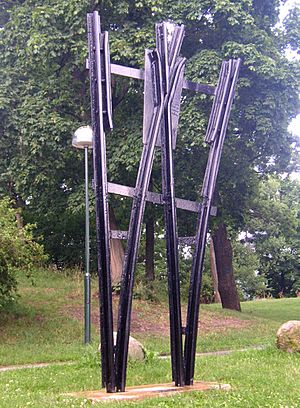Inga Bagge facts for kids
Inga Bagge (born July 24, 1916 – died May 3, 1988) was a talented Swedish artist. She was known for her unique sculptures and paintings. Inga Bagge started her art studies in the mid-1930s. She later attended the Royal Swedish Academy of Fine Arts in the early 1950s. Her early artworks were made from many different and unusual materials. These works quickly gained attention and praise at her first art show in 1958. She continued to create even more surprising pieces. Many of her artworks can be seen in public places and in museums today. One of her most important works is a huge, almost flat sculpture called Livsträdet (Tree of Life), made in 1975. You can see it at Stockholm's Moderna Museet. Inga Bagge also taught art at Konstskolan Idun Lovén.
Contents
About Inga Bagge's Life
Early Life and Art Studies
Inga Bagge was born in Stockholm, Sweden, on July 24, 1916. Her father, Jakob Gustaf Pontus Bagge, was an engineer. Her mother was Tora Augusta Lindberg. Inga was the second of two children in her family. After her mother passed away when Inga was young, her father raised her and her sibling.
In 1926, her family moved to Linköping. After attending a girls' school, Inga began studying art in 1938. She learned from an artist named Leoo Verde at the ABF school. She also studied at Otte Sköld's art school. Around 1940, she married John Henderson Powell, and they had a daughter named Ingela.
Developing Her Unique Art Style
From 1951 to 1957, Inga Bagge studied at the Royal Art Academy. She learned from famous artists like the sculptor Bror Hjorth and the painter Sven Erixson. From Bror Hjorth, she learned how to "build" sculptures. Both of her teachers admired her "nervy and sensitive way of working." In 1968, she created a textile artwork called Hommage à Bror Hjorth, which means "Tribute to Bror Hjorth."
While she was still at the Academy, Inga Bagge started trying out unusual materials. For example, she combined wet rags with plaster. In 1958, she had her first solo art show at the Burén Gallery. An art critic named Ulf Linde was very impressed. He said her artworks had "fine sculptural qualities" and that their strong feeling came from their "inner core of simple cohesion of form."
Finding Inspiration and Creating Masterpieces
In 1963, Inga Bagge saw an exhibition of art by Marcel Duchamp. This experience made her realize that she could create art using anything she wanted! She then made a piece called Såsom jag flyger, titta en spegel (As I fly, look a mirror). This artwork combined a workman's stool with chicken wire, gloves, silk stockings, bicycle locks, plastic flowers, and shoes. Many of her most important works come from this time.
Inga Bagge herself believed that her most significant work was the almost flat sculpture Livsträdet (Tree of Life). She made this piece using various textiles, buttons, beads, sequins, tape, and even a small clutch bag.
Inga Bagge passed away in Järna on May 3, 1988. Her unique and surprising artworks continue to inspire people today.


